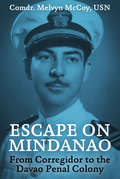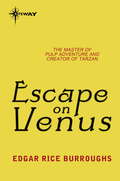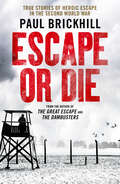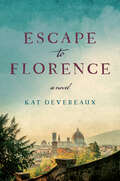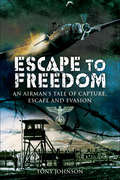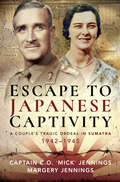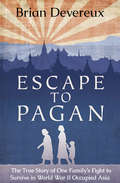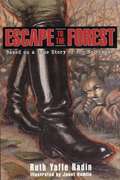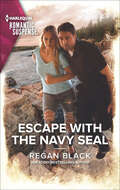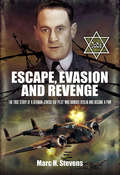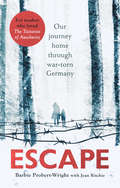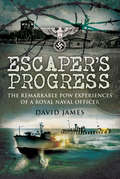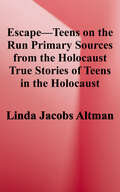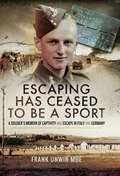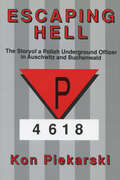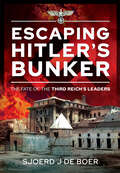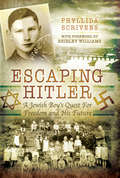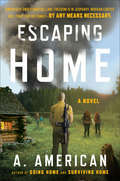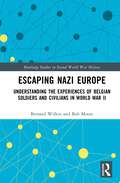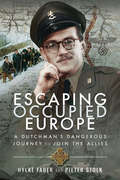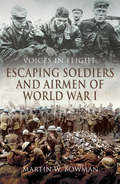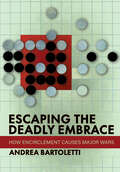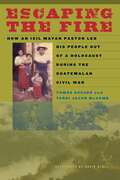- Table View
- List View
Escape on Mindanao
by Lt.-Comm. Melvyn H. McCoyEscape on Mindanao is U.S. Navy Lieutenant Commander Melvyn H McCoy's account of his wartime experiences in the Philippines: the defense and fall of Corregidor Island, the Bataan Death March, his internment in Camp Cabanatuan, his transfer to Bilibid Prison in Manila, and finally being sent to the Davao Penal Colony on Mindanao. From the Davao camp, McCoy escaped and led nine other servicemen and two Filipinos on a hazardous journey to a rendezvous with an American submarine which would take them to freedom and safety in Australia. His daily log provides an insight into the dangers the escapees faced, the difficulties in travelling in the jungles and swamps of Mindanao, harrowing encounters with Japanese patrols, and heartwarming accounts of the generosity and assistance of Filipino citizens and guerrillas along the way.For his service, McCoy was awarded the Distinguished Service Cross. The commendation read as follows: The President of the United States of America, authorized by Act of Congress, July 9, 1918, takes pleasure in presenting the Distinguished Service Cross to Commander [then Lieutenant Commander] Melvyn Harvey McCoy, United States Navy, for extraordinary heroism in action in the Philippine Islands, from 4 April to 9 July 1943. After eleven months as a Prisoner of War, and in weakened physical condition, Commander McCoy outwitted the Japanese guards on 4 April 1943, escaped from a prison camp, eluding pursuing patrols, and made his way on foot and by small boat from the vicinity of Davao to northern Mindanao. Hearing of a United States force in Misamis Occidental he contrived to reach its headquarters on foot and by launch. Arrangements for his evacuation having been made, he continued on foot through enemy-occupied territory. By using mountain trails, he avoided capture by numerous Japanese patrols and arrived at the rendezvous. Commander McCoy's courage in the face of great danger and his fortitude despite his physical weakness enabled him to escape and to rejoin the United States forces with information of great military value.
Escape on Venus: Venus Book 4
by Edgar Rice BurroughsWhen Carson Napier, astronaut from Earth, attempted to help Duare, princess of Vepaja, find her homeland on an unmapped cloud-shrouded planet, they found more trouble than they had ever desired.They found it in Mypos, the country of amphibian people; in the land of the Brokols, whose young grow on trees; and in Voo-ad, the city of the human amoebae. How they escape from their strange predicaments is a thrill-a-page novel of Venus by the author of the famous Tarzan novels.
Escape or Die: Perfect for fans of Damien Lewis' SAS Great Escapes
by Paul BrickhillExtraordinary times. Extraordinary courage.Here, from the bestselling author of The Great Escape, are eight true and startling escape stories from the Second World War.The heroism of the servicemen who dared to defy their captors in this volume is matched only by that of the underground movements and ordinary civilians who helped the escapees in these stories of daring, invention and doggedness against the odds.From the account of the Spitfire pilot left for dead by an execution squad in Sicily to the story of the air gunner forced to blag his way across the Baltic, every one is an unputdownable classic.‘As long as there are prisons men will try to escape from them; and as long as there is an RAF it will bring to the problems of escape the qualities of high resource, pure cussedness and that indefinable, damnably annoying refusal to lie down when dead, of which all the stories in this book are such excellent - and, I think, such exciting - examples.’ H.E. Bates
Escape to Florence: A Novel
by Kat Devereaux"A powerful debut. . . . This richly textured, well-researched novel is about two women whose lives are inextricably intertwined – one a young Italian resistance fighter during WWII, and the other, a woman fleeing her abusive marriage, inspired by her grandmother’s last wish. This moving page-turner is a love letter to Florence - past and present - and filled with all the juicy elements that hist-fic lovers will celebrate: love, passion, history, courage, secrets and second chances." — Lisa Barr, New York Times bestselling author of Woman on FireMoving between the Second World War and the present, an exhilarating debut novel in the vein of Jennifer Robson, Kate Quinn, and Natasha Lester, about two women, decades apart, whose fates converge in Florence, Italy.Only fourteen, Stella Infuriati is the youngest member of her town’s resistance network during World War II. Risking torture and death, she relays messages, supplies, and weapons to partisan groups in the Tuscan hills. Her parents have no idea, consumed instead by love and fear for their beloved son, Achille, a courier and unofficial mechanic for a communist partisan brigade.Then, after 1945, Stella seemingly vanishes from the records. Her name and story are overshadowed by the tragic death of her brother—until a young writer arrives in Tuscany in the spring of 2019, uncovering long-buried secrets.Fleeing an emotionally abusive marriage and a lonely life on an isolated estate, Tori MacNair has come to Florence, the beautiful city her grandmother taught her to love, to build a new life. As she digs into her family history with the help of Marco, a handsome lawyer, Tori starts to uncover secrets of the past—truths that stretch back decades, to a young woman who risked everything to save her world . . .
Escape to Freedom: An Airman's Tale of Capture, Escape and Evasion (Wwii Ser.)
by Tony JohnsonA firsthand account of a World War II crewman in the 427 (Lion) Squadron of the Royal Canadian Air Force who was captured by the Nazis and became a POW.On his third operational mission, Tony Johnson was shot down in his Wellington bomber. Captured shortly after, he was interrogated in Dulag Luft before being sent to Stalag Luft 1 on the Baltic where he stayed from April to September 1944. As the noose tightened on Germany, Tony and his fellow kriegies were kept on the move. He describes the increasingly harsh conditions they all endured, including the infamous Long March of the winter of 1945. He twice escaped, the second time successfully, reaching the Allied Second Army.
Escape to Japanese Captivity: A Couple's Tragic Ordeal in Sumatra, 1942–1945
by Captain C.O. Mick Jennings Margery JenningsThis harrowing WWII memoir recounts the tragic ordeal of a British couple separated by war and taken prisoner by Japanese forces in Sumatra.Captain C.O. “Mick” Jennings and his wife Margery were living in British Singapore when the Japanese invaded in 1941. Margery was on her way to Australia with other British families when their ship was bombed, leading to her capture in Sumatra. When Singapore fell in February 1942, Mick and other soldiers commandeered a junk and sailed to Sumatra. With a fellow soldier, he set sail for Australia in a seventeen-foot dinghy. But after an appalling ordeal at sea, he was also captured.Despite their close proximity, Mick and Margery never saw each other again. Though they managed to exchange a few letters, Margery died of deprivation and exhaustion in May 1945, shortly before VJ day, while Mick miraculously survived.Based on personal accounts and Margery’s secret diary, this outstanding book describes in graphic detail their attempted escapes and horrific imprisonments. Above all it is a moving testimony to the couple’s courage, resilience, and ingenuity.
Escape to Pagan: The True Story of One Family's Fight to Survive in World War II Occupied Asia
by Brian DevereuxThe true story of a soldier who survived Japanese capture, a sinking hell ship, and the bombing of Nagasaki, all while his family fought their own battle in the Burmese jungle. While leading an attack on Hong Kong&’s Golden Hill, Jack Devereux of the Royal Scots is shot through the head. Then a Japanese officer attempts to behead him in order to blood his samurai sword. Waking briefly, Devereux kills his would-be executioner, impressing his captors. Fascinated by their prisoner&’s grisly wounds, they allow him to live, but Devereux&’s trials are only beginning. In a precarious physical state, the wounded soldier experiences the horrific sinking of the Japanese freighter LisbonMaru, in which hundreds of POWs drown; survives the shark-infested South China Sea; and burrows in the mines of Nagasaki as the atom bomb falls. Meanwhile, his family hides in Burma, hoping against hope that they will one day be reunited with Devereux. Written by his son, Brian Devereux—whose mother carried him from Mandalay to the deserted medieval city known today as Bagan—this is an amazing account of the terrifying wartime journey of a soldier and his family.
Escape to the Everglades (Florida Historical Fiction for Youth)
by Edwina Raffa Annelle RigsbyRunning Boy of the Snake Clan of the Seminoles has lived with his uncle in the Everglades since his mother, a Seminole, and his father, a white man, were taken by the Breath Maker. Now he is fourteen and has received his adult name, Will Cypress, at the annual Green Corn Dance. In the eyes of his tribe Will is now a man, and he is eager to prove his courage as a warrior against the U.S. Army in the Second Seminole War. Will's manhood is accepted by all the Seminoles except Tiger, a bully who has always hated Will because of his white blood and superior running and hunting skills. Hoping to convince Tiger of his loyalty to the Snake Clan, Will sets out to join Osceola's band of warriors who are fighting to remain in Florida. On his way to the war chief's camp, Will stumbles upon a family secret that makes the battle for his homeland a personal one. He never loses his will to overcome, even when the whites break their truce and capture the Seminoles and imprison them in the fort in St. Augustine. Will faces the daunting challenge of honoring his heritage while desperately struggling to hold on to his dream. Valuable lessons about friendship, perseverance, and the power of the truth.Next in series > >See all of the books in this series
Escape to the Forest
by Ruth Yaffe RadinWhen the Nazis invade Poland, nothing is safe anymore. Ten-year-old Sarah and her family must leave their home and live in a Jewish ghetto surrounded by barbed wire. There, life is a nightmare of cold and hunger where Nazi soldiers kill Jews at will. But Sarah still hears stories that give her hope-stories about a man who lives in the nearby forest, fighting the Nazis and sheltering other Jews, Sarah's brother thinks they should try to escape to the forest. Her parents think they will be safer where they are, Sarah doesn't know who is right. But as life in the ghetto grows worse and worse, the forest may be their only hope. Based on a true story of life during the Holocaust, this is a heartrending novel of one family's struggle to survive.
Escape with the Navy Seal (The Riley Code #3)
by Regan BlackA Navy SEAL and a childhood friend are pawns in a madman’s vendetta in this romantic suspense thriller by a USA Today–bestselling author.Seeing his shy childhood friend transformed into an intoxicating beauty has thrown Navy SEAL Mark Riley off balance. So much so that he’s caught off guard when a team of kidnappers sweep them into a deadly nightmare. Now he and Charlotte Hanover are hostages to a psychopath wreaking revenge on Mark’s father. Facing danger is Mark’s business, but with Charlotte’s life at stake, he’s never had so much to lose.
Escape, Evasion and Revenge: The True Story of a German-Jewish RAF Pilot Who Bombed Berlin and Became a PoW
by Marc H. Stevens&“A truly remarkable story . . . Marc Stevens has produced a fitting tribute to his father . . . who played a full part in the defeat of Nazi Germany.&” —HistoryOfWar.org Peter Stevens was a German-Jewish refugee who escaped Nazi persecution as a teenager in 1933. He joined the RAF in 1939 and after eighteen months of pilot training he started flying bombing missions against his own country. He completed twenty-two missions before being shot down and taken prisoner by the Nazis in September 1941. To escape became his raison d&’être and his great advantage was that he was in his native country. He was recaptured after each of his several escapes, but the Nazis never realized his true identity. He took part in the logistics and planning of several major breakouts, including The Great Escape, but was never successful in getting back to England. After liberation, when the true nature of his exploits came to light, he was awarded the Military Cross. He then served as a British spy at the beginning of the Cold War before emigrating to Canada to resume a normal life. This is the story of a heavily conflicted young man, alone in a world that is in the midst of destruction. He is afforded an opportunity to help his persecuted people to obtain a small measure of revenge. It is at once a sad yet uplifting tale of thankless and unheralded heroism.&“This is a wartime career that would make any son proud, but Steven&’s real triumph is in writing a biography that will satisfy the most discerning historian.&” —National Defence Journal
Escape: Our journey home through war-torn Germany
by Barbie Probert-WrightTwo sisters.One extraordinary true story.Germany, 1945. Trapped between advancing armies, stranded hundreds of miles from their mother, and with their father missing in action, sisters Barbie and Eva were confronted with an impossible choice.Should they stay and face invasion or risk their lives to find their mother?Together, they set out on a perilous three-hundred mile journey on foot across a country ravaged by war. Fuelled by courage and love, Eva and seven-year-old Barbie encounter incredible hardship, extraordinary bravery, and overwhelming generosity.Against all odds, they both survived.But neither sister came out of the journey unscathed . . .This is the powerful true story of their escape.(Previously published as Little Girl Lost)
Escaper’s Progress: The Remarkable POW Experiences of a Royal Naval Officer
by David JamesDavid James was in Motor Gunboats (with Robert Hichens of Gunboat Command.) Captured in February 1943 after abandoning ship as a result of a fierce engagement with three German armed trawlers in the North Sea he was imprisoned in Dulag Marlag.His first tunnel was discovered before completion. In December 1943 he succeeded in escaping during the weekly bath house visit and was on the run for almost a week disguised as an officer of the Royal Bulgarian Navy. He was captured after several close calls while attempting to board a ship at Lubeck.In February 1944 he escaped again this time dressed as a Swedish sailor and traveled by train to Bremen, Hamburg, Lubeck, Rostock finishing up in Danzig, all the while searching for a suitable ship. He eventually succeeded in reaching Stockholm after 2 days in the extreme heat of a ships engine room. His superbly written narrative is full of suspense and excitement.
Escape—Teens on the Run: Primary Sources From the Holocaust (True Stories of Teens in the Holocaust Series)
by Linda Jacobs Altman"Discusses children and teens on the run during the Holocaust in Europe, including the different ways young people escaped the Nazis, places of refuge in Europe, and hiding and resistance."- Provided by publisher
Escaping Has Ceased to Be a Sport: A Soldier's Memoir of Captivity and Escape in Italy and Germany
by Frank UnwinAfter being taken prisoner at Tobruk and transported to Italy, the author was determined to escape and learnt Italian by talking to the sentries. His first escape lasted just one week. He then joined a tunnel party and escaped again. After six weeks on the run he was offered shelter in a Tuscan hilltop village, Montebenichi. There he enjoyed five months of freedom, living the lifestyle and ancient customs of these peasant people.While attempting to re-join the Allied armies, Frank and two fellow POWs were re-captured and sent to a brutal work camp in Germany. His defiant attitude exacerbated an already difficult situation. In March 1945, with the Allies closing in Frank took part in The Long March, walking for several weeks before being released by American troops. The title of this remarkable and moving memoir results from a notice posted to Franks amusement in all POW camps saying Escaping has ceased to be a Sport.' This is an exceptional Second World War POW account by a man who refused to accept captivity.
Escaping Hell: The story of a Polish underground officer in Auschwitz and Buchenwald
by Kon PierkarskiEscaping Hell is the compelling and true story of a heroic young Polish officer who survived the terror of five years in the prisons of Auschwitz and Buchenwald – where violence was meaningless because human life had lost all value. During World War II, Kon Piekarski was a member of the Polish Underground Army, a clandestine resistance movement which operated even inside Auschwitz – organizing spectacular escapes, operating a secret radio network and matching wits with the Gestapo. After Auschwitz, Piekarski became a prisoner of war at Buchenwald and spent time working in a factory where Russian prisoners of war were used for labour. In the face of constant danger, he and his comrades took every possible opportunity to sabotage the German war industry. He was finally transferred to a small camp near the French border, and escaped three months before the end of the war.
Escaping Hitler's Bunker: The Fate of the Third Reich's Leaders
by Sjoerd J. de BoerAs the Soviet troops fought their way ever closer to the Reich Chancellery in the final days of the Third Reich, deep underground in Hitler’s bunker fateful decisions were being made. Hitler and some of those closest to him resolved to commit suicide, whilst others sought to try and escape. But who did manage to slip past the Russian soldiers and reach freedom? How did they escape, and what routes did they take through the ruined streets of Berlin? Equally, what became of those who escaped, where did they go, and what happened to those who did not get away? All of these questions are answered in this book. Following years of research in Berlin, the author has been able to identify the various groups and individuals that left the bunker and has traced the paths taken by those who escaped and those that perished. The final days in Hitler’s bunker are revealed in atmospheric detail, as the Red Army closed in and the inevitable end loomed menacingly nearer with the passing of every hour. Many notable persons, such as Bormann, Speer, Göring and Hanna Reitsch, went to say a last farewell to the Führer, while others, such as Goebbels, prepared themselves for suicide rather than being taken prisoner by the Russians. By using detailed maps showing the escape routes, first-hand testimony from those who survived, photographs of the devastated German capital in 1945, as well as images of the various routes as they can be followed through Berlin today, the author explores the last moments of the Third Reich in startling clarity.
Escaping Hitler: A Jewish Boy's Quest for Freedom and His Future
by Phyllida ScrivensEscaping Hitler is the true story, covering ninety years, of a fourteen-year-old boy Gnter Stern who, when Adolf Hitler threatened his family, education and future, resolved to escape from his rural village of Nickenich in the German Rhineland. In July 1939 Gnter boarded a bus to the border with Luxembourg, illegally crossed the river and walked alone for seven days through Belgium into Holland, intent on catching a ferry to England and freedom. The outcome was not exactly as he had planned. The author gathered her information through interviews with Gnter, now known as Joe Stirling, and with those closest to him. During an emotional foot-stepping journey in September 2013 the author visited Gnters birthplace, met with a school friend, discovered the apartment in Koblenz where he fled following Kristallnacht in 1938, drove the route of Gnters walk through Europe and retraced the final steps of his parents prior to their deportation to a Nazi death camp in Poland during 1942.
Escaping Home: A Novel (The Survivalist Series #3)
by A. AmericanBook 3 of The Survivalist Series When society ceases to exist, who can you trust? After the collapse of the nation's power grid, America is under martial law--and safety is an illusion. As violence erupts around him, Morgan Carter faces one of his most difficult decisions yet: whether to stay and defend his home, or move to a more isolated area, away from the prying eyes of the government. He and his family are hesitant to leave their beloved Lake County, but with increasingly suspicious activities happening in a nearby refugee camp, all signs point towards defecting. Morgan and his friends aren't going to leave without a fight, though--and they'll do anything to protect their freedoms. From the author of the hit survivalist novels Going Home and Surviving Home, Escaping Home describes the struggle to live in a world with no rules, and how, sometimes, the strength of family is the only thing that can pull you through.
Escaping Nazi Europe: Understanding the Experiences of Belgian Soldiers and Civilians in World War II (Routledge Studies in Second World War History)
by Bob Moore Bernard WilkinThis book chronicles the escapes attempted by Belgian soldiers and civilians from Nazi-occupied Europe during the Second World War. Insofar as is practical, the authors have tried to let the subjects speak for themselves by making extensive use of their testimonies preserved in archives in Belgium and the United Kingdom. The book begins with the stories of soldiers who managed to evade capture in the summer of 1940 and returned home, and the few that decided to continue the fight and joined the Allied forces in the United Kingdom. It also includes the prisoners of war who managed to escape from camps or Arbeitskommando inside the Reich and provides a detailed analysis of their narratives: their motivation for going on the run, their choices on when and how to travel, and the many obstacles they encountered along the way. Most escapees were content to return home, with some then joining resistance organisations, but a small minority were committed to joining the Allies, and further chapters recount their attempts to reach Spain and Switzerland, and the additional problems they encountered in those neutral states. Final chapters reflect on the penalties inflicted on prisoners of war who were recaptured and on the escapees’ struggle for recognition in the post-war world.
Escaping Occupied Europe: A Dutchman's Dangerous Journey to Join the Allies
by Hylke FaberIt is 1943, and in occupied Holland the Nazis have declared that all students must sign a Declaration of Loyalty, or face the penalty of forced labor in Germany. Medical student Danil de Moulin refuses. A member of the Dutch resistance and in danger of being arrested and sentenced to death, he decides to escape to England and join the Allies to fight the Axis occupation of his motherland.Escaping Occupied Europe tells the remarkable story of De Moulins journey in his own words. His engaging and authentic style make this a unique document about the journey undertaken by Dutch men and women - 'Engelandvaarders' - during the war.'When, moments later we turned to look, we saw that the Gestapo was driving slowly behind us. There was no doubt that we were being followed. This realization, although sensational, was anything but pleasant We were convinced that we had been caught and expected to be arrested at any moment. It was odd, really, that we were so calm and talked nonsense about how we might harass the Nazis during our interrogation'
Escaping Soldiers and Airmen of World War I: Escaping Soldiers And Airmen Of World War I (Voices in Flight)
by Martin W. BowmanThis thrilling new volume from Martin Bowman focusses on British, Canadian, Australian and German soldiers and airmen who were captured during the First World War. Determined that they wouldnt spend the rest of the conflict incarcerated uselessly behind bars, they endeavored to escape. These are their stories.All aspects of prison life are covered here, and the author examines the various escape tactics that were employed by British soldiers and airmen held in PoW camps all over Germany and Turkey. In order to provide a balanced account, the author has also uncovered stories of German navy and army escapees who attempted to flee from England.Each chapter is preceded by an account which explains the types of camps used in Britain and Germany, the numbers involved, the food, the camp money system for worker prisoners and a general appreciation of the conditions and chronology. Firsthand accounts from the prisoners themselves are then woven into the picture, creating an authentic sense of the PoW experience.The emphasis of this unique book is placed on the human story of the main characters, the unparalleled action on the Western Front and the interaction and camaraderie experienced between soldiers and airmen held in prison camps in England, Germany and Turkey during the Second World War.
Escaping from the Kaiser: The Dramatic Experiences of a Tommy POW
by H. W. TustinOnly a week after joining the 8th Durhams in April 1915 Private Herbert Tustin was captured at the Battle of Ypres. He describes the horror of trench warfare, his treatment on being taken a POW and the three day train journey into Germany.There followed 16 months captivity at Rennbahn POW Camp with its hunger, hardships, brutality, work regime, friendships, humour and the different national characteristics of fellow POWs.In late summer 1916 together with a Canadian POW, Gerrie Burk, the author escaped over the wire. For the next 10 days travelling by night, sleeping rough and stealing basic food they headed for Holland. Somehow they miraculously managed to avoid re-capture despite the closest of calls. Once on the Dutch coast they found a boat, SS Grenadier to carry them across the mine-strewn, submarine infested North Sea to England, arriving on 18 September.This amazing story of war, imprisonment, escape and survival concludes with the author's wife recalling the hero's welcome home, the joyful reunion and his proposal of marriage.
Escaping the Deadly Embrace: How Encirclement Causes Major Wars (Cornell Studies in Security Affairs)
by Andrea BartolettiEncirclement, Andrea Bartoletti argues, is an essential strategic possibility of the international system and a key trigger of major war. Using historical case studies, Escaping the Deadly Embrace examines how great powers try to escape the two-front war problem and seek to preserve their security. Encirclement is a geographic variable that occurs in the presence of one or two great powers on two different borders of the surrounded great power. The surrounding great powers may not have the capacity to initiate a joint invasion. Yet their threatening presence triggers a double security dilemma for the encircled great power, which has to disperse its army to secure its borders. When the surrounding great powers become capable of launching a two-front attack, the encircled great power initiates war. This situation, disastrous in itself, can also lead to war contagion when other great powers intervene in the new conflict owing to the rival-based network of alliances. Combining archival work and historiographical analysis, Escaping the Deadly Embrace demonstrates the efficacy of this by assessing three major wars: the Italian Wars, the Thirty Years' War, and World War I. These findings, Bartoletti shows, have important implications for future major wars. Challenging the current focus on the US-China rivalry, he argues that the most concerning strategic scenario is the encirclement of China by India and Russia.
Escaping the Fire: How an Ixil Mayan Pastor Led His People Out of a Holocaust During the Guatemalan Civil War
by David Stoll Tomás Guzaro Terri Jacob MccombDuring the height of the Guatemalan civil war, Tomás Guzaro, a Mayan evangelical pastor, led more than two hundred fellow Mayas out of guerrilla-controlled Ixil territory and into the relative safety of the government army’s hands. This exodus was one of the factors that caused the guerrillas to lose their grip on the Ixil, thus hastening the return of peace to the area. In Escaping the Fire, Guzaro relates the hardships common to most Mayas and the resulting unrest that opened the door to civil war. He details the Guatemalan army’s atrocities while also describing the Guerrilla Army of the Poor’s rise to power in Ixil country, which resulted in limited religious freedom, murdered church leaders, and threatened congregations. His story climaxes with the harrowing vision that induced him to guide his people out of their war-torn homeland. Guzaro also provides an intimate look at his spiritual pilgrimage through all three of Guatemala’s main religions. The son of a Mayan priest, formerly a leader in the Catholic Church, and finally a convert to Protestantism, Guzaro, in detailing his religious life, offers insight into the widespread shift toward Protestantism in Latin America over the past four decades. Riveting and highly personal, Escaping the Fire ultimately provides a counterpoint to the usual interpretation of indigenous agency during the Guatemalan civil war by documenting the little-studied experiences of Protestants living in guerrilla-held territory.
